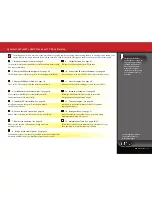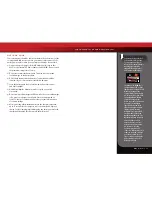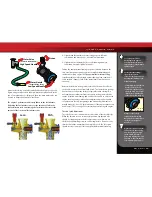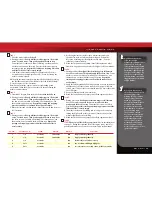
18
•
Revo 3.3
THE TRX 3.3 RACING ENGINE
TERMS TO KNOW
You’ll find these Nitro R/C engine terms throughout this section
of the manual.
.15
- .15 or “15” refers to the displacement of the engine. The TRX 2.5
Racing Engine is .15 cubic inches or 2.5 cubic centimeters (cc). The
name “TRX 2.5” is derived from the cc measurement.
.20 -
.20 or “20” refers to the size of the engine. The TRX 3.3 is .20
cubic inches or 3.3 cubic centimeters (cc). The name “TRX 3.3” is
derived from the cc measurement.
ABC
- Abbreviation for aluminum, brass, and chrome. Refers to
engine construction that consists of an aluminum piston that slides
in a chrome-plated brass sleeve. The TRX 3.3 uses ABC construction.
Air filter
- The air filter sits atop the carburetor and prevents harmful
dust and dirt from entering the engine. Dirt ingestion is the number
one cause of premature engine failure so the engine should never
be run without the air filter in place.
BDC
- Bottom dead center. The bottom-most position of the engine
piston stroke.
Break-in
- Break-in is the procedure for running a brand new engine
according to specific instructions. This correctly prepares the engine
for normal running. The break-in procedure can be different for
different makes of engines. Follow the Traxxas directions for break-
in exactly.
Carb
- Abbreviation for carburetor.
Carburetor
- The carburetor atomizes (mixes) the fuel with the air
so that the engine can burn it. There are two types of carburetors;
slide carbs and barrel carbs. The TRX 3.3 uses the superior slide
carburetor design.
Clean-out
- Cleaning-out is a condition that occurs when the engine
is accelerating and the fuel mixture becomes sufficiently lean to
allow the engine to continue into its upper rpm power band. It
is usually characterized by a noticeable decrease in blue exhaust
smoke and a dramatic increase in engine speed.
Combustion chamber
- The combustion chamber is machined into
the bottom of the cylinder head. This is where the glow plug ignites
the fuel. The shape of the combustion chamber is designed to
promote more efficient burning of the fuel.
Connecting rod
- The connecting rod transfers the piston motion
to the crankshaft. The TRX 3.3 Racing Engine uses a “knife-edged”
connecting rod. The aerodynamic, sharpened edges allow it to
“slice” through the pressurized air/fuel mixture inside the crankcase.
Crankcase
- The engine’s “body” that contains all of the running
mechanical components.
Crankshaft
- The main shaft of the engine that holds the
reciprocating assembly.
Cooling fins
- The cooling fins are milled into the cylinder head and
crankcase and cause heat to be drawn away from the engine. Heat
is removed when it dissipates into the air passing across the cooling
fins. It is important to keep the fins clean of dirt and debris for
maximum cooling efficiency.
Cylinder head (head)
- The finned aluminum part on top of the
engine that is responsible for dissipating most of the engine’s heat.
The combustion chamber is machined into the bottom of the head.
Dyno
- Abbreviation for dynamometer. A precise piece of testing
equipment that accurately measures engine power and torque
output over the engine’s entire rpm range.
EZ-Start
- Traxxas on-board electric starting system. The system
consists of a hand held starter control unit and an on-board
gearbox with an electric motor to spin the engine.
Fit
- Usually refers to the fit of the piston and sleeve. If the fit is tight,
the piston will feel very tight at top of the sleeve (top dead center),
and the engine will have good sealing and compression. If the fit
is loose, compression will be low and both the piston and sleeve
should be replaced.
Flame-out
- Occurs when the engine stops running at high rpm.
Usually the fault of an excessively lean fuel mixture or glow
plug failure.
Fuel
- (10%, 20%, 33%) The TRX 3.3 must have model engine fuel to
run. Traxxas Top Fuel
™
is recommended. Fuel is sold in quarts and
gallons from hobby dealers. The 10%, 20% and 33% labeling refers
to the percentage of nitromethane contained in the fuel.
Fuel mixture
- The ratio of fuel to air as determined by the needle
settings of the carburetor.
Fuel tubing (fuel line)
- The thick silicone tubing that carries fuel
from the fuel tank to the carburetor.
Glow plug
- The glow plug is located in the cylinder head at the top
of the combustion chamber. It contains an element that glows red
hot when voltage is applied. When the engine is being started,
the heat from the glow plug ignites the fuel mixture and starts the
combustion process.
Glow plug driver
- This tool clips onto the glow plug and supplies the
required voltage to light the glow plug element. It is also called an
igniter. EZ-Start equipped engines do not require this separate tool.
Header
- The aluminum tube that connects the exhaust system to the
engine exhaust port. The length and diameter of the header must
be carefully selected to extract the most power from the engine.
















































